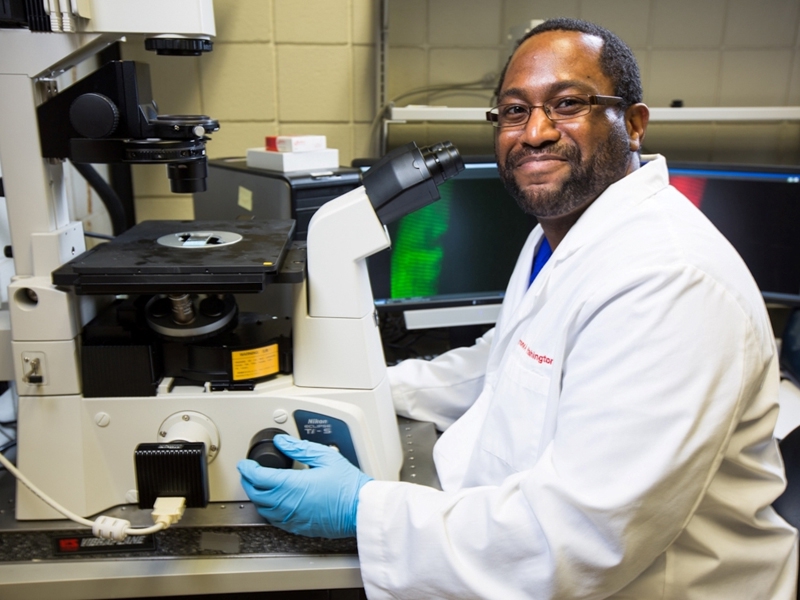
Volumetric muscle loss often occurs with significant traumas such as battlefield injuries caused by stepping on an improvised explosive device, crush injuries in car accidents and some resection procedures such as tumor removal.
College of Education and Health Professions faculty member Tyrone Washington was recently awarded a $434,793 National Institutes of Health R15 award to explore how to help enhance recovery following devastating events like these.
Washington, a professor of exercise science in the Department of Health, Human Performance, and Recreation, is the principal investigator on the three-year grant.
Co-investigators include exercise science faculty colleagues Nicholas Greene and Kevin Murach and the head of the U of A biomedical engineering department, Jeff Wolchok. Students will also contribute substantially to the project, giving them unique, hands-on training in high-end biomedical research.
"Receiving funding from the NIH is a thrilling milestone, as it fuels my long-held passion for understanding skeletal muscle regeneration — a field I've been dedicated to exploring since 2001," Washington said.
He's grateful to have met Wolchok at a chancellor's dinner for new faculty back in 2011. Wolchok introduced Washington to volumetric muscle loss — a more traumatic type of muscle damage in which full regeneration does not occur.
"This opportunity will allow me to delve deeper into the science I've always believed holds transformative potential for regenerative medicine," Washington added.
Current volumetric muscle loss treatments have a ceiling of about 80 percent force recovery. This leads to a long-term inability to carry out otherwise normal daily activities. Washington and Wolchok have been researching new ways to extend beyond this current ceiling in recovery by combining surgical repair and physical exercise approaches.
The NIH grant will leverage these combined approaches to improve current treatment paradigms and enhance recovery and long-term physical function following volumetric muscle loss injuries.
Washington developed a keen interest in muscle regeneration as a graduate student in James Carson's laboratory. Carson is currently the director of the Huffines Institute for Sports Medicine and Human Performance and a professor at Texas A&M. He was trained by some of the most preeminent scientists in the field of muscle biology. Washington was deeply immersed in Carson's study of muscle plasticity, which is defined as the ability of a given muscle to alter its structural and functional properties in accordance with the environmental conditions imposed on it.
"Through this training, I developed a passion for all things muscle but more specifically, skeletal muscle regeneration," Washington said. "My dissertation actually examined the role of inflammatory cytokine interleukin-6 (IL-6) during skeletal muscle hypertrophy and skeletal muscle regeneration. So, this has been an interest of mine for some time."
Carson said hearing the news of Washington's NIH funding is gratifying. "One of the true joys of being a professor is following your former students' successes over the years," he said. "Tyrone was one of the first students to work with me in my laboratory, which I had just started as an assistant professor at the University of South Carolina. I am not sure why, but I am incredibly grateful he took a chance on an unproven adviser, and we went on to make a great team that took him through his Ph.D. and produced numerous impactful publications."
Carson noted that funding from the NIH is extraordinarily competitive and involves a rigorous review of the proposed project and investigator by a panel of peers who are established experts. "Tyrone's NIH funding is a fitting validation of his research standing and achievements and demonstrates his continued efforts to develop and generate impactful research for the foreseeable future," he said.
Nicholas Greene, director of the U of A Exercise Science Research Center, has worked with Washington since 2013. He also lauded Washington's research and achievements. "As biomedical researchers, funding from the NIH is considered one of the ultimate barometers of professional success," Greene said. "Tyrone has worked diligently and tirelessly to develop his research program and to develop the students, undergraduate and graduate, that he has worked with since his arrival to the University of Arkansas faculty."
Topics
Contacts
Shannon G. Magsam, director of communications
College of Education and Health Professions
479-575-3138, magsam@uark.edu